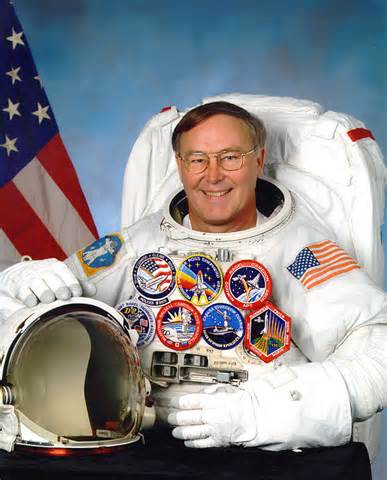
1.) From star-gazing ten-year-old to “most-launched astronaut in history,” your uniquely American story inspires, conveys wisdom. In between, however, you had to overcome serious obstacles. Upon whom did you rely during trying times?
I rely upon God to help me each day of my life. Whenever I face tough decisions or challenging circumstances, I look to Him for guidance and help. It is great having a wonderful helper and guide! My wife Karen has been my best friend and helper. She is supportive and has always encouraged me to pursue exciting and rewarding career choices.
2.) You assisted building the International Space Station (ISS). Such an engineering marvel did not come flawlessly. Why was this project so puzzling?
The ISS is an impressive complex of hardware, but it is not puzzling. It is the way it is because that is what it took to make everything work. A very challenging design that had to meet many often-conflicting requirements. The assembly was almost totally flawless, but that was because of all the hard work and attention to detail that we did on the ground before we launched the hardware into orbit.
3.) Astronauts, an elite cohort, sometimes suffer from depression following their space days. After missions have you encountered a sense of earthly emptiness?
I did have a “blue funk” after my last flight. I was very disappointed that I would most-likely never get to fly in space again. When the Columbia accident occurred shortly after my last flight, the loss of my friends just made that depressed state stronger and longer. It was not an overpowering or disabling situation; I helped lead the search for the Columbia debris, but it was just a challenging time in my life. I talk about this question in my book.
4.) Together with NASA, private companies (e.g. SpaceX) are advancing technology. What implications might this new era generate?
One of the biggest advances will be reusing the launch rocket. If the commercial launch companies can do that reliably and it significantly reduces the costs of launching hardware into space that will be a big step forward.
5.) Mars is a near-future destination. Will we revisit our moon? About how far away is tourism?
We need to go to the moon and learn how to live there for long durations. We need to demonstrate on the moon that we have extremely reliable systems that will work in harsh conditions for many years without the need for repair. These systems need to be highly efficient and allow us [to] regenerate our oxygen and water, and make our own food so that we don’t need to [bring] tremendous amounts of supplies. It is only 2 1/2 days to and from the moon to earth. It is 9 months each direction to Mars and you need to stay there on/near Mars for about 1 year to make the return trip feasible with current rocket technologies. The trip to Mars is not going to happen in the “near term”. Space tourism will likely start in a small way in the next five years. But I don’t expect it to ever grow to be very large. I don’t consider sub-orbit flights to be space tourism. I consider them to be very risky “manned cannon shots”.
Books
- Spacewalker: My Journey in Space and Faith as NASA’s Record-Setting Frequent Flyer
- Becoming a Spacewalker: My Journey to the Stars
Learn More about Jerry Ross
- Wikipedia entry
- NASA profile
- Personal website
- Space Safety Magazine interview
- Smithsonian’s Air & Space Magazine interview
Topics Mentioned